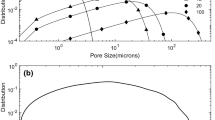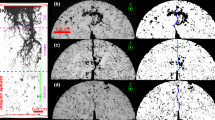Summary
This study investigates the changes in deformation and stress dependent hydraulic conductivities that occur as a result of underground mining in intact and fractured porous media. The intact porous medium is assumed to be comprised of regularly packed spherical grains of uniform size. The variation in grain size or pore space due to the effect of changing intergranular stresses results in a change in rock hydraulic conductivity. A model is developed to describe the sensitivity of hydraulic conductivity to effective stresses through Hertzian contact of spherical grains. The fractured porous medium is approximated as an equivalent fracture network in which a single fracture is idealized as a planar opening having a constant equivalent thickness or aperture. Changes in fracture aperture as a result of changes in elastic deformation control the variation of hydraulic conductivity. A model is presented to illustrate the coupling between strain and hydraulic conductivity. Subsidence induced deformations that result from mining induced changes in hydraulic conductivity in both intact and fractured media. These changes are examined and compared with results from a mining case study.
Similar content being viewed by others
References
Barton, N., Bandis, S., Bakhtar, K. (1985): Strength, deformation and conductivity coupling of rock joints. Int. J. Rock Mech. Min. Sci. Geomech. Abstr. 22 (3), 121–140.
Bear, J. (1972): Dynamics of fluids in porous media. American Elsevier Pub., Boulder, 764 pp.
Biot, M. A. (1941): General theory of three dimensional consolidation. J. Appl. Phys. 12, 155–164.
Brandt, H. (1955): A study of the speed of sound in porous granular media. J. Appl. Mech. 22, 479–486.
De Wiest (ed.) (1969): Flow through porous media, Academic Press, London, 530 pp.
Einstein, H. H., Dowding, C. H. (1981): Shearing resistance and deformability of rock joints. In: Touloukian, Y. S., Judd, W. R., Roy, R. F. (eds.), Physical properties of rocks and minerals, McGraw-Hill, New York, 177–220.
Elsworth, D. (1989): Thermal permeability enhancement of blocky rocks: one dimensional flows. Int. J. Rock Mech., Min. Sci. Geomech. Abstr. 26 (3/4), 329–339.
Elsworth, D., Xiang, J. (1989): A reduced degree of freedom model for thermal permeability enhancement in blocky rock. Geothermics 18, 691–709.
Freeze, R. A., Cherry, J. A. (1979): Groundwater. Prentice-Hall, Englewood Cliffs, 604 pp.
Gale, J. E. (1982): The effects of fracture type (induced versus natural) of the stress-fracture closure-fracture permeability relationship. 23rd U.S. Rock Mech. Symp., Univ. of California, Berkeley, 290–298.
Gangi, A. F. (1978): Variation of whole and fractured porous rock permeability with confining pressure. Int. J. Rock Mech. Min. Sci. Geomech. Abstr. 15(3), 249–257.
Geertsma, J. (1957): The effect of fluid pressure decline on volumetric changes of porous rocks. Trans. AIME, 331.
Hasenfus, G. J., Johnson, K. L., Su, D. W. H. (1988): A hydrogeomechanical study of overburden aquifer response to longwall mining. In: Proc., 7th Int. Conf. Ground Control in Mining, Morgantown, WV, 149–162.
Hoek, E., Bray, J. W. (1977): Rock slope engineering, 2nd edn., Inst. Min. and Metall., London, 402 pp.
Hubbert, M. K. (1940): The theory of ground water motion. J. Geol., 48, 785–944.
Iwai, K. (1976): Fundamental studies of fluid flow through a single fracture. Ph.D. Dissertation, University of California, Berkeley, 268 pp.
Jones, F. O. (1975): A laboratory study of the effects of confining pressure on fracture flow and storage capacity in carbonate rocks. J. Petrol. Technol., 21–27.
Kozeny, J., Ber, S. (1927): Wiener Akad, Abt. 2a, 136, 271.
Kranz, R. L., Frankel, A. D., Engelder, T., Scholz, C. H. (1979): The permeability of whole and jointed Barre granite. Int. J. Rock Mech. Min. Sci. Geomech. Abstr. 16(3), 225–234.
Krumbein, W. C., Monk, G. D. (1943): Permeabillity as a function of the size parameters of unconsolidated sand. Trans. Am. Inst., Min. Metall. Petrol. Engng. 151, 153–163.
Louis, C. (1969): Groundwater flow in rock masses and its influence on stability. Rock Mech. Res. Report 10, Imperial College, UK.
Nur, A., Byerlee, J. D. (1971): An exact effective stress law for elastic deformation of rock with fluids. J. Geophys. Res. 76(26), 6414–6419.
Robin, P. Y. F. (1973): Note on effective pressure. J. Geophys. Res. 78(14), 2434–2437.
Rosso, R. S. (1976): A comparison of joint stiffness measurements in direct shear, triaxial compression, and in situ. Int. Rock Mech. Min. Sci. Geomech. Abstr. 13, 167–172.
Scheidegger, A. E. (1957): The physics of flow through porous media. Macmillan, New York, 236 pp.
Skempton, A. W. (1960): Effective stress in soils, concrete and rock. Pore pressure and suction in soils, Butterworths, London.
Snow, D. T. (1968): Rock fracture spacings, openings, and porosities. J. Soil Mech. Found Div., Proc. ASCE 94, 73–91.
Terzaghi, K. V. (1923): Die Berechung der Durchlässigkeitsziffer des Tones aus dem Verlauf der hydrodynamischen Spannungserscheinungen. Sitzungsber. Akad. Wiss. Wien Math Naturwiss. Ki. Abt. 2A, 132, 105.
Timoshenko, S. (1934): Theory of elasticity, 1st edn., McGraw-Hill, New York 416 pp.
Walsh, J. B. (1981): Effect of pore pressure and confining pressure on fracture permeability. Int. Rock Mech. Min. Sci. geomech. Abstr. 18(3), 429–435.
Warren, J. E., Root, P. J. (1963): The behavior of naturally fractured reservoirs. J. Soc. Pet. Eng. 3, 245–255.
Witherspoon, P. A., Wang, J. S. Y., Iwai, K., Gale, J. E. (1980): Validity of Cubic law for fluid flow in a deformable rock fracture. Water Resour. Res. 16(6), 1016–1024.
Young, A., Low, P. F., Mclatchie, A. S. (1964): Permeability studies of argillaceous rocks. J. Geophys. Res. 69, 4237–4245.
Author information
Authors and Affiliations
Rights and permissions
About this article
Cite this article
Bai, M., Elsworth, D. Modeling of subsidence and stress-dependent hydraulic conductivity for intact and fractured porous media. Rock Mech Rock Engng 27, 209–234 (1994). https://doi.org/10.1007/BF01020200
Issue Date:
DOI: https://doi.org/10.1007/BF01020200




